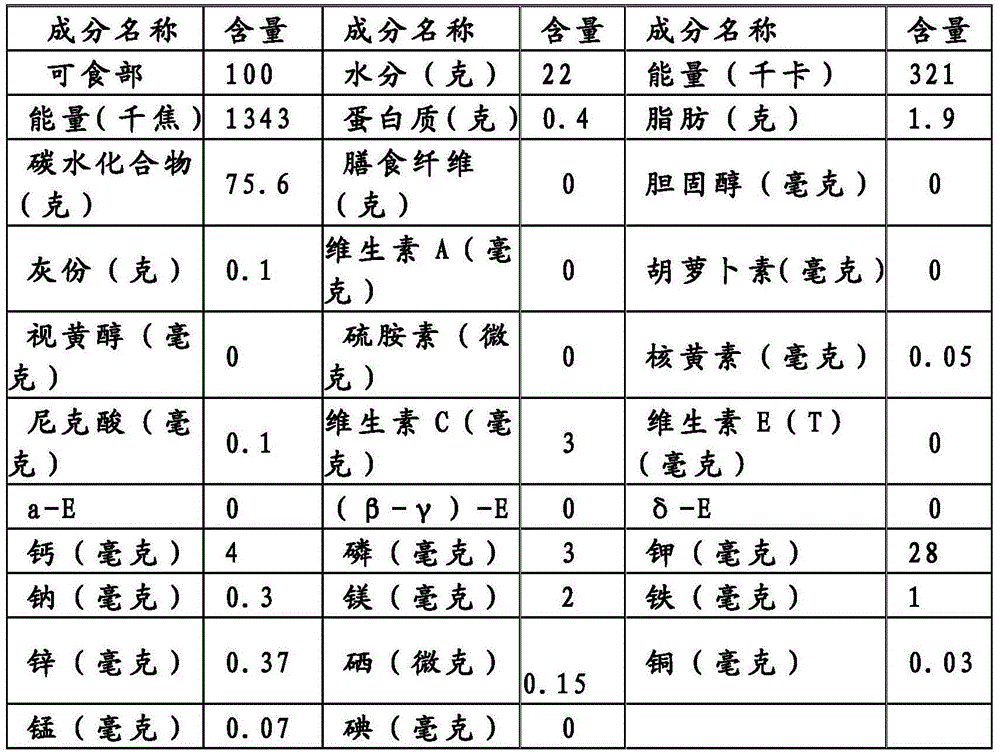Loquat fruit wine and production method thereof
A production method and technology of loquat fruit, applied in the field of loquat fruit juice wine and its production, can solve the problems of indistinct personalization, little change in style, and low technical content, and achieve controllable fermentation technology, increased added value, and technological equipment simple effect
- Summary
- Abstract
- Description
- Claims
- Application Information
AI Technical Summary
Problems solved by technology
Method used
Image
Examples
Embodiment 1
[0061] (1) Raw material processing: select the loquat fruit with high maturity, no mildew and black spots, remove the stalk and remove impurities, wash with water, drain, remove the core and crush to obtain 300kg of pulp with skin.
[0062] (2) Adjustment of berries: transfer the crushed loquat pulp with peel into a pottery jar, add 40.5g of potassium metabisulfite, and then add 120g of pectinase, and at the same time adjust the pH of the pulp to 3.70 with citric acid, and mix well.
[0063] (3) Inoculation and fermentation: add 270g wine active dry yeast to the adjusted loquat pulp with skin.
[0064] (4) Fermentation changes: The temperature of the wine mash is 25°C for main fermentation. When the temperature rises to 28°C, the rake is opened in time to control the temperature, so that the temperature drops to 26°C, and the main fermentation continues for 7 days.
[0065] (5) add wine inhibition: add the Xiaoqu Baijiu that accounts for 30% of the wine mash gross weight after...
Embodiment 2
[0079] (1) Raw material processing: select the loquat fruit with high maturity, no mildew and black spots, remove the stalk and remove impurities, wash with water, drain, remove the core and crush to obtain 300kg of pulp with skin.
[0080] (2) Adjustment of berries: transfer the crushed loquat pulp with peel into a pottery tank, add 45g of potassium metabisulfite, and then add 130g of pectinase, and use citric acid to adjust the pH of the pulp to 3.80, and mix well.
[0081] (3) Inoculation and fermentation: add 280g wine active dry yeast to the adjusted loquat pulp with skin.
[0082] (4) Fermentation changes: The temperature of the wine mash is 25°C for the main fermentation. When the temperature rises to 28°C, the rakes are opened in time to control the temperature, so that the temperature drops to 26°C, and the main fermentation continues for 6 days.
[0083] (5) add wine inhibition: add the Xiaoqu Baijiu that accounts for 30% of the wine mash gross weight after the main ...
Embodiment 3
[0097] (1) Raw material processing: select the loquat fruit with high maturity, no mildew and black spots, remove the stalk and remove impurities, wash with water, drain, remove the core and crush to obtain 300kg of pulp with skin.
[0098] (2) Adjustment of berries: transfer the pulp of crushed loquat with peel into a pottery jar, add 50 g of potassium metabisulfite, and then add 140 g of pectinase, and adjust the pH of the pulp to 3.80 with citric acid, and mix well.
[0099] (3) Inoculation and fermentation: add 295g wine active dry yeast to the adjusted loquat pulp with skin.
[0100] (4) Fermentation changes: The temperature of the wine mash is 25°C for the main fermentation. When the temperature rises to 28°C, the rakes are opened in time to control the temperature, so that the temperature drops to 26°C, and the main fermentation continues for 5 days.
[0101] (5) Inhibition by adding wine: adding Xiaoqu liquor accounting for 30% of the total weight of the main fermented...
PUM
 Login to View More
Login to View More Abstract
Description
Claims
Application Information
 Login to View More
Login to View More - R&D
- Intellectual Property
- Life Sciences
- Materials
- Tech Scout
- Unparalleled Data Quality
- Higher Quality Content
- 60% Fewer Hallucinations
Browse by: Latest US Patents, China's latest patents, Technical Efficacy Thesaurus, Application Domain, Technology Topic, Popular Technical Reports.
© 2025 PatSnap. All rights reserved.Legal|Privacy policy|Modern Slavery Act Transparency Statement|Sitemap|About US| Contact US: help@patsnap.com



